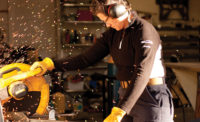In the HVAC industry, safety is everything. Your technicians are constantly handling dangerous materials on a daily basis, and it’s important to technicians, their employers, and end users that employees are protected while on duty. While it was once viewed as unmanly or unnecessary to wear safety gear and be trained on best safety practices by some, it’s now the new norm.
“Before it was tough [to get technicians to comply with safety standards]. Ten to 12 years ago, it was a macho thing not to wear safety gear — we didn’t wear a helmet or anything. Now, we stress the importance of safety to our technicians and installers with a lot of safety training,” said John Aliano, owner of Aksarben American Residential Services (ARS) of Omaha, which was honored as ARS’s Best Overall Safety Branch at the franchise’s 2016 annual meeting in Las Vegas.
In addition, the pressure to comply with Occupational Safety and Health Administration (OSHA) regulations and standards is an industry must. On Dec. 1, 2016, OSHA released its “Recommended Practices for Safety and Health Programs in Construction” guidelines designed to help industry employers develop proactive programs to keep their workplaces safe. The recommendations are described as being particularly helpful to small- and medium-sized contractors who lack safety and health specialists on staff.
Contractors can create a safety and health program using a number of simple steps that include training workers on how to identify and control hazards, inspecting the job site with workers to identify the problems with equipment and materials, and developing responses to possible emergency scenarios in advance.
“The recommendations outlined in this document will help contractors prevent injuries and illnesses on their construction sites and make their companies more profitable,” said Dr. David Michaels, assistant secretary of labor for occupational safety and health.
WHERE TO START
As ongoing regulations continue to reshape the industry, many contractors agree training on safety protocols must occur more than once a year. Many contractors have begun implementing mandatory, weekly training on a safety subject of their choice. A common theme is to use OSHA’s training.
“Annually, we train on all of OSHA’s required trainings, including confined space, fall protection and inspection, electrical safety and LOTO [control of hazardous energy], HAZCOM [hazardous communication], and asbestos,” said Ryan Kelly, safety manager, Waldinger Corp., Des Moines, Iowa.
Rob Minnick, CEO and president of Minnick’s Inc. in Laurel, Maryland, brings in an OSHA-certified safety manager once a month that is set up through his insurance agent.
“He [our safety trainer] comes in once a month,” Minnick said. “Be it CPR, driving safely, or working on ladders and scaffolds, there is a whole slew of anything and everything for him to concentrate on. He gives me a list and goes through each subject once a month. Anything OSHA wants I completely agree with because if our guys aren’t being safe, they are harming themselves, their families, the company, and our customers,” said Minnick.
At the core, contractors should consider hitting on the key factors at play when it comes to technicians’ safety, such as protecting technicians from hazards related to utilizing hazardous materials and chemicals, machinery and equipment, electrical issues, falls, and more.
Once you’ve implemented someone to conduct the training, be diligent. Some contractors, such as Todd Kletz, owner of One Hour Heating & Air Conditioning in Virginia Beach, Virginia, offer different trainings every day but always make sure to include safety topics on at least one of the days.
“We train our techs on certain topics every day for a half-hour in the morning,” Kletz said. “It’s important that we all congregate here every morning, and we hold a company-wide safety training event every Wednesday.”
WHAT’S IN IT FOR ME?
Now that you’ve trained them, how do you ensure they stick with it when they’re out on the job? First off, make sure you’re manning your technicians with proper safety gear at all times, regardless of size or budget.
“Small businesses are inundated with regulations and often don’t have the resources and manpower to address all the requirements, including new safety standards,” said Mike McCullion, director, market sectors and safety, Sheet Metal & Air Conditioning Contractors’ National Association (SMACNA).
While you may be a smaller company, and safety gear costs can be high, it’s not a corner you can afford to cut. If you want a safe staff, provide them with safety gear — period.
Aliano has found it to be very beneficial to incentivize. He organizes his technicians into safety teams of six to eight people. If someone has an accident, it’s a hit against their team. This procedure serves as a sense of peer pressure to do things right.
“Bad actions can cost the team a bad reflection on their safety skills,” Aliano said. “It’s been a team-building experience to get our guys to believe in [safety protocols].”
Teams are incentivized to win prizes and are ranked based on their safety skills. If someone messes up in the field, points are docked from the team. To keep numbers strong, friendly competitions are waged with the ultimate goal of keeping everyone safe and healthy.
Another common theme is to give away prizes, hold safety contests, or provide free paid days off to probe technicians into staying on track with their safety measures. When interviewing contractors, this seemed to be a common practice that encourages everyone to stay on the same page.
Accountability is a huge factor when it comes to safety in the field, said Minnick.
“Our field supervisors go on-site and verify techs are doing what they are supposed to,” he added.
And one last tip to consider, don’t forget to pair your top safety technicians with new technicians or those who struggle to follow best safety practices. A solid mentor can mold a technician into a safety guru in no time.
Publication date: 12/19/2016
Want more HVAC industry news and information? Join The NEWS on Facebook, Twitter, and LinkedIn today!







